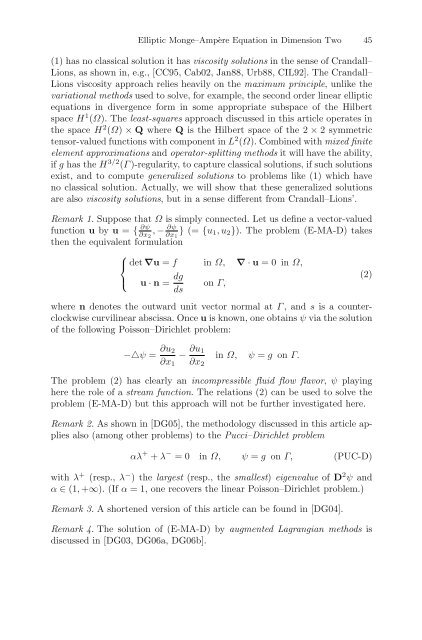Partial Differential Equations - Modelling and ... - ResearchGate
Partial Differential Equations - Modelling and ... - ResearchGate
Partial Differential Equations - Modelling and ... - ResearchGate
Create successful ePaper yourself
Turn your PDF publications into a flip-book with our unique Google optimized e-Paper software.
Elliptic Monge–Ampère Equation in Dimension Two 45<br />
(1) has no classical solution it has viscosity solutions in the sense of Cr<strong>and</strong>all–<br />
Lions, as shown in, e.g., [CC95, Cab02, Jan88, Urb88, CIL92]. The Cr<strong>and</strong>all–<br />
Lions viscosity approach relies heavily on the maximum principle, unlike the<br />
variational methods used to solve, for example, the second order linear elliptic<br />
equations in divergence form in some appropriate subspace of the Hilbert<br />
space H 1 (Ω). The least-squares approach discussed in this article operates in<br />
the space H 2 (Ω) × Q where Q is the Hilbert space of the 2 × 2 symmetric<br />
tensor-valued functions with component in L 2 (Ω). Combined with mixed finite<br />
element approximations <strong>and</strong> operator-splitting methods it will have the ability,<br />
if g has the H 3/2 (Γ )-regularity, to capture classical solutions, if such solutions<br />
exist, <strong>and</strong> to compute generalized solutions to problems like (1) which have<br />
no classical solution. Actually, we will show that these generalized solutions<br />
are also viscosity solutions, but in a sense different from Cr<strong>and</strong>all–Lions’.<br />
Remark 1. Suppose that Ω is simply connected. Let us define a vector-valued<br />
function u by u = { ∂ψ<br />
∂x 2<br />
, − ∂ψ<br />
∂x 1<br />
} (= {u 1 ,u 2 }). The problem (E-MA-D) takes<br />
then the equivalent formulation<br />
⎧<br />
⎨ det ∇u = f in Ω, ∇ · u =0 inΩ,<br />
⎩ u · n = dg<br />
(2)<br />
on Γ,<br />
ds<br />
where n denotes the outward unit vector normal at Γ ,<strong>and</strong>s is a counterclockwise<br />
curvilinear abscissa. Once u is known, one obtains ψ via the solution<br />
of the following Poisson–Dirichlet problem:<br />
−△ψ = ∂u 2<br />
∂x 1<br />
− ∂u 1<br />
∂x 2<br />
in Ω, ψ = g on Γ.<br />
The problem (2) has clearly an incompressible fluid flow flavor, ψ playing<br />
here the role of a stream function. The relations (2) can be used to solve the<br />
problem (E-MA-D) but this approach will not be further investigated here.<br />
Remark 2. As shown in [DG05], the methodology discussed in this article applies<br />
also (among other problems) to the Pucci–Dirichlet problem<br />
αλ + + λ − =0 inΩ, ψ = g on Γ, (PUC-D)<br />
with λ + (resp., λ − )thelargest (resp., the smallest) eigenvalue of D 2 ψ <strong>and</strong><br />
α ∈ (1, +∞). (If α = 1, one recovers the linear Poisson–Dirichlet problem.)<br />
Remark 3. A shortened version of this article can be found in [DG04].<br />
Remark 4. The solution of (E-MA-D) by augmented Lagrangian methods is<br />
discussed in [DG03, DG06a, DG06b].
















